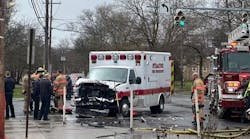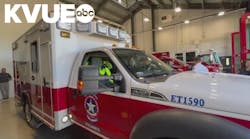Simply stated, fire-rescue command personnel need to function in a strong, central management position in order to be successful. In the two early articles in this series on the basics of command, we discussed the principle of the incident management system (August 1996) and then the duties and responsibilities of the incident commander (October 1996). Now, let's take a practical look at just how the system comes together and is applied at an alarm. This article will review the initial portion of incident operations.
Once a specific IMS departmental policy has been prepared and all members have been properly trained in its implementation, it is time to begin using the system. These two critical steps cannot be overlooked as foundations to the transition into IMS. Further, there are several supporting policies that must be in place and understood before the system will work as advertised. These policies deal with standard company operations, communications and dispatch procedures. Departments should reach out for help in developing and teaching these policies and procedures. Much information and assistance is available for the asking. In fact, a National Incident Management Symposium is held in Phoenix each September. This is a great place to get a wealth of information about IMS and to network with other practitioners.
After the preparation is complete and the apparatus is responding to a call for help, "the rubber meets the road." Upon arrival, the apparatus is properly placed, taking advantage of the visual size-up information and topography. The officer must ensure that the area is safe to operate in, considering that the situation can change rapidly (apparatus placement and scene safety are topics that should get consideration at all alarms). The system gets started by the first-arriving officer making a brief initial report (BIR). Six items make up the BIR:
Confirm incident address. Incident description. Incident conditions. Request for assistance, if needed. Initial action plan. Assumption of command.Let's take a detailed look at each item and see how it is applied.
The company officer indicates that his or her unit has arrived on location by restating the incident address. This action will confirm the incident address to responding apparatus as well as letting the Communications Center correct any mistake that could have been made in locating the incident. One example: "Engine 10 to Communications on location at 4315 Jones Terrace." At this point, the Communications Center can make required adjustments if needed, such as, "Communications to Engine 10, the correct address is 4315 Jones Street."
Next, the incident description is transmitted by the arriving company officer. This action continues to paint a picture for the additional responding companies as well as the command officer. It sounds like this: "Engine 10 to Communications on location at 4315 Jones Street with a two-story ordinary-construction single-family dwelling." Based on this part of the BIR, the mental preparation should be enhanced for the responding units. Considerations for specific equipment and procedures are cued by this information. As part of the IMS procedures, there should be a standard incident description list that is used for this part of the BIR. Building construction descriptions should follow the five National Fire Protection Association (NFPA) building construction types. Remember, the incident management system is designed for "all risks" (all types of calls). Therefore, the BIR should be applied at incidents other than structural fires. One example might be, "Engine 10 to Communications on location at 4315 Jones Street with a two-vehicle automobile accident."
The incident conditions should now be added to the BIR. This part of the process is somewhat subjective based on the officer's perception. The officer should add the observed conditions to the report: "Engine 10 to Communications on location at 4315 Jones Street with a two-story ordinary-construction single-family dwelling, there is heavy smoke showing from the second floor."
Once again, the officer has provided vital information to the initial report that will help responding companies and the Communications Center plan for what happens next. For instance, the Communications Center may initiate move-up procedures to fill stations that will be busy handling this incident. Other responding officers can continue the mental preparation process.
Many departments will change response modes at this point in the process, based on the on-scene conditions. For instance, if the call was to a structural fire and there was nothing showing, indicating no fire, then responding units would reduce their response to non-emergency. This action limits the potential for vehicle accidents. The reverse would hold true if the call for help started off as a non-emergency situation but escalated into an emergency.
At this point in the process, if conditions require it, call for help. All emergency incidents are "front loaded" events. They require large numbers of people and equipment at the right place and at the right time to be successful. What happens in the first few minutes at an incident will determine success or failure of our operations. The company officer does not need to be responsible for assigning tasks to the additional units. He or she needs to determine the amount of work that must be accomplished and match the required resources to this estimate. The additional requested units can be assigned to Level II staging until there is time to blend them into the action plan. Level II staging will give the incident commander time to properly place the additional companies. If you think that you may need one additional engine, the odds are that you will need two more. The radio description sounds like this: "Engine 10 to Communications on location at 4315 Jones Street with a two-story ordinary-construction single-family dwelling, there is heavy smoke showing from the second floor. Dispatch a second alarm."
The initial actions are now transmitted by the officer. The action plan identifies the steps that are going to be taken to resolve the situation. Every incident should have an action plan. The elements of the action plan are the incident priorities, strategy, tactics and required resources. As a quick review, the three elements of the incident priorities are: life safety (the firefighters and the customers); incident stabilization (stop the incident from spreading); and property conservation (prevent further loss).
To continue the scenario, "Engine 10 to Communications on location 4315 Jones Street with a two-story ordinary-construction single-family dwelling, there is heavy smoke showing from the second floor. Dispatch a second alarm. Engine 10 will start search and rescue in the fire area."
The last element of the BIR is the assumption of command. This must include the identity and location of the incident commander. The identity of the person assuming command will be important to the later-arriving command officers to assist in the transfer-of-command process. The location will be useful in locating command for communications and meeting purposes. Here's what the finished product should sound like: "Engine 10 to Communications on location 4315 Jones Street with a two-story ordinary-construction single-family dwelling, there is heavy smoke showing on the second floor. Dispatch a second alarm. Engine 10 will start search and rescue in the fire area. Lieutenant Painter is Jones Street Command." The Communications Center would now repeat this transmission to ensure that all units responding had the opportunity to hear this vital information.
The process of the brief initial report may seem to require a lot of time and effort to implement. The truth is that you can't afford not to use this part of the system if you expect to be successful. In fact, with just a little practice the BIR will be easy to master. It is just like any other moving parts of the incident management system. Once they are understood and practiced, they become second nature and quickly gain acceptance within your organization.
The BIR process makes for a great training session. All it takes are some slides or pictures of various types of incidents in your response area, radio equipment on an alternate frequency and a person to role play as the dispatcher. Try out the system and have some fun with it by taping the radio traffic and playing it back for critique purposes.
In closing, the six elements of the brief initial report process are simple and straightforward. They should be incorporated into a standard operating procedure and practiced regularly. Just like in the world of business management, information at an emergency incident is the key to success. There are many excuses out there blocking departments from the implementation of a comprehensive incident management system. If you look beyond the negative information and seek the safest and most effective way of delivering our services to the customer, part of the answer is the proper use of the incident management system. Until next time, safe firefighting!
BRIEF INITIAL REPORT
- Confirm incident address.
- Incident description.
- Incident conditions.
- Request for assistance if needed.
- Initial action plan.
- Assumption of command.





